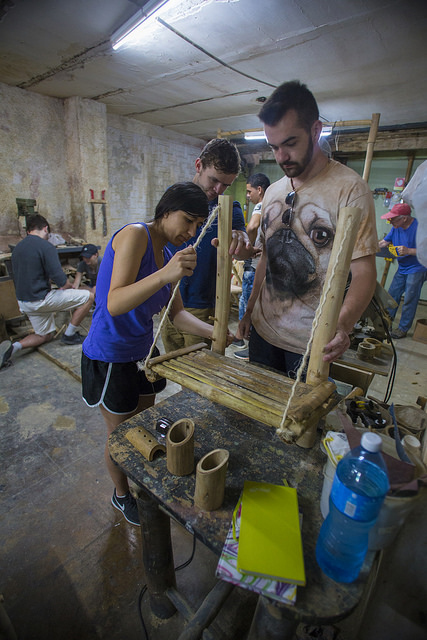Faculty and students at a bamboo workshop in Havana, Cuba, discuss ideas and sketches prior to constructing their objects out of bamboo. Photo: Garreth Blackwell, faculty, VCUarts
By Emi Endo
Imagine finding yourself 1,000 miles away on an island — where you may not speak the local language — with only hours to identify and to solve a design problem. You are teamed up with people not trained in your field and you’re restricted to one material: bamboo.
That’s the experience that 15 Virginia Commonwealth University engineering and arts students found themselves immersed in earlier this summer during the university’s first Designing Cuba intensive study abroad workshop. The course was the brainchild of Russell D. Jamison, Ph.D., Alice T. and William H. Goodwin Jr. Chair of Engineering Education, professor of Biomedical Engineering and Chemical and Life Science Engineering and dean emeritus of the VCU School of Engineering. The students explored the concept of design within constraint — using bamboo as an example and the location of newly reopened Cuba as the environment.
Sara Reed, Ph.D., an adjunct professor of interior design at the VCU School of the Arts, led the program. She said examples of ingenuity and creating within constraint abounded at the bamboo workshop that hosted the students. “Living with great material scarcity has led them to some solutions that may never have been explored,” Reed said, citing how workers repurposed a car wheel into a tool for making bamboo dowels. “Examples like this illustrate how they have had to purposefully find alternate solutions to construction and building.”

(Left to right) Sofia Duarte, Cullen Bade (MNE) and Connor Quatannens assemble a shelf that will be used in an Old Havana apartment. Photo: Garreth Blackwell, faculty, VCUarts
Jamison said that instead of teaching innovation and creativity through a limitless “blue sky, think outside the box” approach, “We look at the empowering force of constraint on design thinking. In some ways it is like becoming MacGyver — improvising solutions in seemingly impossible circumstances. You’re in a locked concrete cell with nothing but a coat hanger and roll of duct tape. What are you going to do now? Once the initial panic and hopelessness subsides, it is remarkable how quickly creative solutions begin to form. Constraint frees the mind to innovate.”
The students from the VCU School of Engineering, VCU School of the Arts and College of Humanities and Sciences, were placed on interdisciplinary teams. Each team was assigned a different residential or business space to observe. The teams identified design problems to address in those locations and brainstormed possible solutions, with the goal of designing and building one prototype out of bamboo.
Jasmen Cheese, a rising senior in the Department of Chemical and Life Science Engineering, said, “I was a little nervous about us not being able to finish our prototype in time.” But they did. Her teammates designed furniture for an ice cream vendor, building a table with adjustable legs and a facade that held ice cream cones. The goal was to help the vendor make better use of his small stall and to make it more convenient for him to retrieve his ice cream cones.
Cheese said each of her team members brought different strengths to the process and the final project. “I don’t think our prototype would have been the same if we were all engineers,” she said.
Students could use the tools available at the bamboo workshop, owned by Carlos Martínez Romero, a furniture builder trained as a civil engineer, and his wife, Gisela Vilaboy, an artist.
Biomedical engineering doctoral student Anisa Kannan, who went on a pilot trip to Cuba in 2016, returned to help lead the course along with Reed, Garreth Blackwell, Ph.D., instructor at the VCUarts Center for the Creative Economy, and Camden Whitehead, associate professor of interior design at the VCU School of the Arts.
Kannan, who previously traveled with other VCU Engineering World Health chapter members to provincial hospitals in Nicaragua to repair broken medical equipment, said the biggest lesson was getting such real-world, hands-on experience in “the process of design thinking.” Learning how to research and look at a problem in a different society “without bringing your assumptions in” is critical in any career that requires creative thinking, she said.
Meet the owners of bamboo workshop Bambú Centro, in Havana, Cuba, which hosts VCU’s interdisciplinary design program. Filmmaker Cody Huff, a 2016 VCUarts graduate, participated in a 2016 pilot trip and created this documentary.
